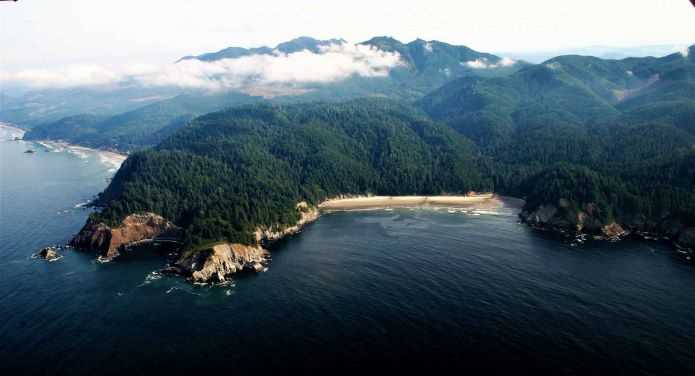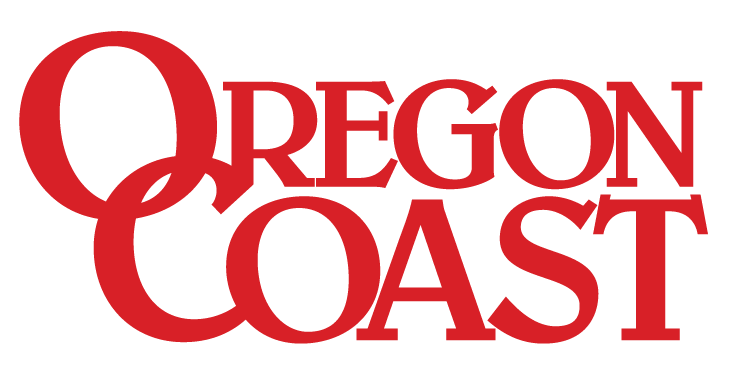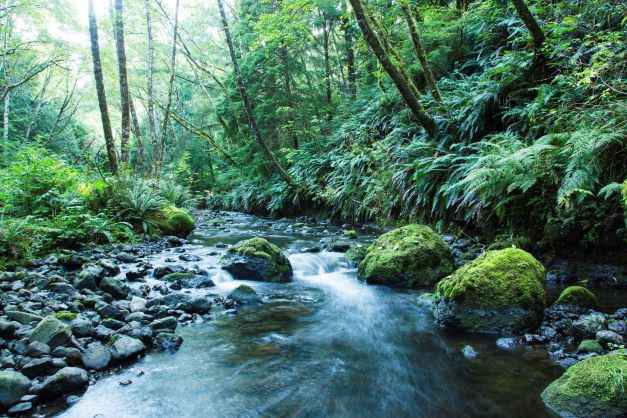North Coast Land Conservancy spearheads effort to preserve large temperature rainforest south of Cannon Beach.
On October 26, 2021, on the heels of a five-year campaign spearheaded by North Coast Land Conservancy, the Rainforest Reserve was permanently conserved as a place brimming with critical habitat for a wide array of wildlife and plant species.
Located adjacent to Oswald West State Park and east of Cape Falcon Marine Reserve, the Rainforest Reserve is part of an uninterrupted 32-square-mile conservation corridor that stretches from the summits of 3,000-foot peaks within the Oregon Coast Range to Short Sand Beach and beyond to the sandy seabed and rocky reefs of the nearshore ocean. This type of protected land-to-sea corridor is unmatched in the state of Oregon.
“Bringing this land into conservation allows us to unlock its future,” NCLC Executive Director Katie Voelke said. “It is a living, breathing, flowing and evolving place. Conservation allows it to live its most dynamic and abundant life. This is a living museum, a living laboratory, a globally rare and precious place, and it’s our community backdrop. Conserving this land gives us all a chance to be in the right relationship with the land and the people it sustains.”
The reserve includes the headwaters of five watersheds and the protected area provides drinking water to Cannon Beach and Arch Cape. As a result, conservation of the Rainforest Reserve will help ensure clean drinking water for residents and visitors and could help lower water treatment costs.
Protection of the proposed Rainforest Reserve has been a goal of coastal conservationists for decades. Seventy years ago, Oregon’s first state parks superintendent, Sam Boardman, characterized the property as “one of the greatest opportunities for creating one of the outstanding natural parks in the nation.” However, a sense of awe and respect for this place has existed in the peoples living here since time immemorial. This summit-to-sea corridor has provided abundant first foods, materials for tools and crafts, and more for the Clatsop and Tillamook people. NCLC is committed to ensuring indigenous Clatsop and Tillamook community members have access to this land for a variety of cultural uses.
Campaign Background
In 2016, North Coast Land Conservancy entered into talks with EFM Inc., a forestland investment management company committed to sustainable forestry. That led Onion Peak Holdings, a subsidiary managed by EFM, to purchase 5,000 acres of forestland from Stimson Lumber Company. In keeping with EFM’s goals around enabling long-term land ownership, landscape protection and drinking water security, they signed a purchase and sales agreement with NCLC with a deadline of five years.
“NCLC’s compelling vision for this property inspires us to think bigger and be bolder in solving our climate crisis,” EFM CEO Bettina von Hagen said. “The creation of the Rainforest Reserve is an enormous contribution to the people of Oregon, who will have the opportunity to hike and enjoy this spectacular and unique landscape, and to the many plants and animals, including endemic species, that make the Rainforest Reserve home. We applaud NCLC for their vision, perseverance and tenacity in making this five-year vision a reality.”
To secure the Rainforest Reserve and complete this landmark conservation project, NCLC raised roughly $11.8 million with the help of more than 1,000 donors and significant grants awarded by U.S. Fish and Wildlife; Pacific Northwest Resilient Landscapes Initiative, a partnership among the Land Trust Alliance, Oregon Community Foundation, Seattle Foundation and the Idaho Community Foundation, with support from Doris Duke Charitable Foundation; Oregon Watershed Enhancement Board (OWEB); and M.J. Murdock Charitable Trust. In addition, NCLC continues to provide technical support to the Arch Cape Water and Sanitary Districts to acquire an additional 1,500 acres to create a community forest adjacent to the Rainforest Reserve.
“It’s been astounding to see what’s happened with fundraising for the project and the grants that came through,” NCLC Board President John Mersereau said. “Now that we have the property, there’s also the question of, what’s next? What is involved in the next phase? There is so much work to be done, but having met that initial goal with the acquisition is huge.”

An interim public recreation policy—including what uses will be permitted and where—is currently in place, while creation of a more robust and thoughtful public-access plan is underway. Through a grant from NPS, a team of conservation and recreation planning specialists are facilitating that planning process with NCLC, neighboring landowners, community members at-large, and indigenous community members. Over the next year, they will be reaching out to the community to help create a cohesive, interconnected recreation and access plan that is user-friendly and provides opportunities to the public while also protecting ecologically sensitive areas.
“The Rainforest Reserve is unique in its connection to not only an incredible state park but also a marine protected area,” added Nadia Gardner, volunteer chair of Friends of Cape Falcon Marine Reserve. “We are thrilled to see this area protected from the mountain peaks out into Oregon’s ocean.”
Press release and photos provided by North Coast Land Conservancy




